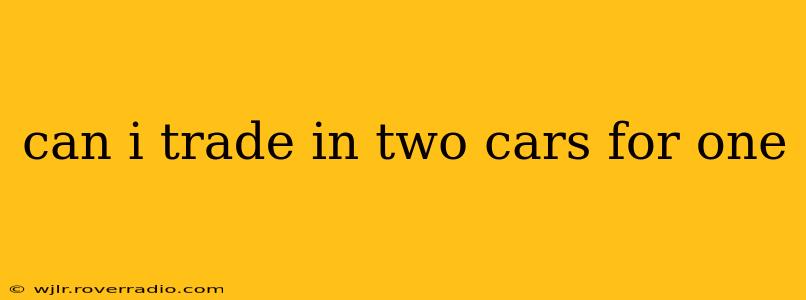Trading in multiple vehicles for a single new or used car is entirely possible, and it's a smart move for many people looking to simplify their lives and potentially save money. However, navigating the process requires understanding how dealerships handle multiple trade-ins and how to maximize your value. This guide will cover everything you need to know.
How Does Trading in Two Cars Work?
The process of trading in two cars is similar to trading in one, but with a few key differences. Essentially, you're negotiating the value of each vehicle separately, then combining those values to offset the cost of your new car. Dealerships will appraise each vehicle individually, considering factors such as make, model, year, mileage, condition, and market value. They'll then provide you with a trade-in offer for each. These offers might be lower than what you'd get selling the cars privately, but the convenience of a single transaction often outweighs the potential difference.
What Are the Benefits of Trading in Two Cars?
- Simplified Process: Instead of selling two cars individually, you streamline the process into a single transaction. This saves you time and effort involved in advertising, showing vehicles, and negotiating with multiple buyers.
- Potential Savings: By combining the trade-in values, you could significantly reduce the amount you need to finance or pay upfront for your new car.
- Convenience: Everything is handled at one location, making the entire experience much more convenient.
What Factors Affect the Value of Your Trade-ins?
Several factors influence the value the dealership assigns to your trade-in vehicles:
- Market Demand: The popularity of your car's make and model significantly impacts its value. High-demand vehicles will generally fetch better trade-in offers.
- Condition: A well-maintained vehicle in excellent condition will command a higher price than one with significant wear and tear, damage, or mechanical issues.
- Mileage: Lower mileage generally translates to a higher trade-in value.
- Year and Model: Newer models typically hold their value better than older ones.
- Features: Extra features like leather seats, navigation systems, or advanced safety technologies can increase your trade-in value.
How to Maximize Your Trade-in Value
To get the best possible deal, consider these strategies:
- Research Market Value: Before visiting a dealership, research the Kelley Blue Book (KBB) or Edmunds values for your vehicles. This provides a benchmark to compare against the dealer's offer.
- Prepare Your Vehicles: Clean and detail your cars thoroughly before taking them to the dealership. A clean car presents better and can lead to a higher appraisal.
- Shop Around: Get appraisals from multiple dealerships to compare offers. Dealerships are competitive, and you might find a significantly better deal at one location versus another.
- Negotiate: Don't be afraid to negotiate the trade-in value. Start with the KBB or Edmunds value as your starting point.
- Consider Selling Privately: If you're confident in your ability to sell privately, consider this option, particularly for vehicles in high demand. You might get a better price, but it requires more time and effort.
What if One Car Has Problems?
Dealerships will still typically accept vehicles with minor mechanical issues, but the trade-in value will likely be lower. Be upfront about any known problems with your vehicles. Hiding issues could lead to complications later in the transaction.
Can I Trade in Two Cars of Different Ownership?
Yes, you can generally trade in two cars even if they are under different ownership (e.g., you and your spouse). You will need to provide proper documentation for each vehicle, including titles and registration information. The dealership will guide you through the necessary paperwork.
What Documents Do I Need?
Be prepared to bring the titles, registration documents, and proof of insurance for both vehicles.
By understanding the process, researching your vehicle's value, and negotiating effectively, you can successfully trade in two cars for one and get the best possible deal. Remember, preparation and research are key to a successful trade-in experience.
